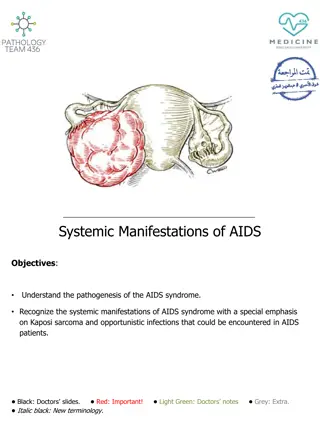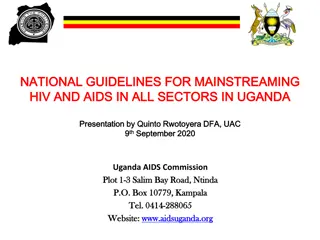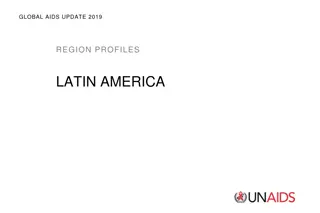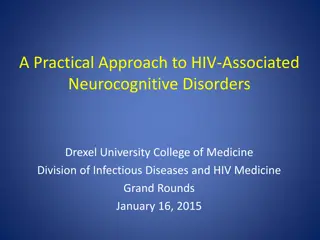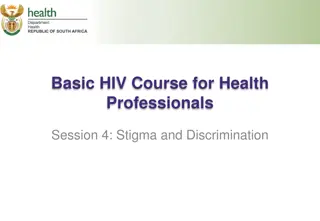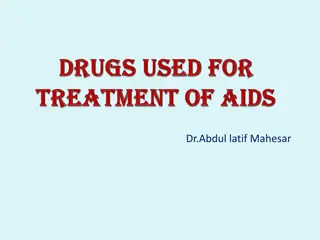Understanding HIV and AIDS: The Progression in Adult Natural History
HIV infection progresses in stages from acute infection with flu-like symptoms to a latency period of no symptoms, then advancing to AIDS where the immune system is significantly weakened, leading to opportunistic infections and HIV-related cancers. The virus targets CD4 cells, impacting the immune system's ability to fight off infections. Untreated, advanced HIV can lead to death. It is crucial to understand the progression of HIV and AIDS for effective management and treatment.
Download Presentation

Please find below an Image/Link to download the presentation.
The content on the website is provided AS IS for your information and personal use only. It may not be sold, licensed, or shared on other websites without obtaining consent from the author. Download presentation by click this link. If you encounter any issues during the download, it is possible that the publisher has removed the file from their server.
E N D
Presentation Transcript
TREATMENT LITERACY MODULE 4 Treatment Literacy
HIV in the Body: Adult Natural History Most people will have mild flu-like symptoms two to four weeks after being infected Some have no symptoms or don t recall any The risk of transmitting the virus at this stage is very high Person gets infected with HIV and it multiplies very rapidly acute Infection The virus quietly and slowly multiplies clinical latency No signs/symptoms Latent period for two to more than 10 years The immune system is still strong The virus damages certain organs and the general immune system following rapid replication of the virus advanced HIV or Acquired Immune Deficiency Syndrome (AIDS) Some signs/symptoms, due to weakening immune system Opportunistic Infections (OIs) and/or cancers are able to survive and dominate the very weak immune system
HIV and the Immune System The immune system in the body tries to protect it from foreign agents like germs and cancer cells. There are many type of cells and substances involved in the immune system. T-lymphocytes (T cells) are one type of white blood cell in the immune system. HIV attacks the T cells that have a special receptor (molecule) called CD4, so these lymphocytes often are called CD4 cells. (HIV has the key to unlock and enter the CD4 door of the T cell)
HIV and its Effect on CD4 Cells A person gets infected with HIV and it multiplies very rapidly acute infection CD4 is usually high, well above 500 cells/ml Viral load (VL) is just starting to climb The virus quietly and slowly multiplies clinical latency CD4 is usually above 200 499 per ml and VL is at a steady level The virus damages certain organs and the general immune system, following rapid replication of the virus Advanced HIV or AIDS CD4 is below 200 cells/ml VL above 100,000 cop/ml
HIV and AIDS As HIV damages the CD4 cells, the immune system becomes weaker. A person can start getting infections when the immune system cannot effectively fight them off; untreated opportunistic infections (OIs) can eventually lead to death due to immunodeficiency. When the immune system gets to an extremely deteriorated state at a certain point in the most advances stages this deficiency in the immune system is called advanced HIV, or Acquired Immune Deficiency Syndrome (AIDS). The World Health Organization defines AIDS as the occurrence of any of more than 20 OIs or HIV-related cancers. Source: World Health Organization. 2016. HIV/AIDS. Available at: http://www.who.int/features/qa/71/en/.
An Example of an Advanced HIV Condition Pruritic Papular Eruption (PPE) Itchy, diffuse rash Occurs mostly on the arms and legs, but trunk and face involved in 50% of cases Does not appear on the palms of hands or soles of feet
Common AIDS-defining Conditions Candidiasis (gullet or airway disease) Fungal infection caused by yeasts belonging to the genus Candida Candida is a normal growth in the body. With lower immunity, overgrowth of candida can cause symptoms to develop Candida that develops in the mouth or throat is called thrush or oropharyngeal candidiasis Candida that develops in the vagina is commonly referred to as yeast infection If it progresses to the throat, lungs, or esophagus, is an AIDS- defining condition Pneumocystis carinii pneumonia (PCP) (lung) - In people with healthy immune systems, it does not cause any problems - In people with HIV, it can multiply quickly in the lungs, causing pneumonia - PCP is now treated prophylactically (prevented) with an antibiotic, such as Bactrim - - - - - Recurrent pneumonia (2 or more episodes per year) Cervical cancer (invasive/has spread past the neck of womb) - Condition where fluid builds up in the lungs and can cause coughing and/or shortness of breath. Two or (usually) more separate episodes usually with fever, leukocytosis (high white blood cell count), and purulent (pus) sputum production These episodes are separated by an interval of at least one month without symptoms or clearing of the chest visible by radiograph - Caused by some strains of human papillomavirus (HPV) Develops at the neck of the womb Women with HIV infection have a higher risk of developing cervical cancer - - - -
Common AIDS-defining Conditions 2 Toxoplasmosis (commonly affects the brain) A parasite that infects the brain and sometimes the heart and lungs Common ways this diseases is transmitted include via cat feces and soil HIV wasting syndrome (weight loss, diarrhoea) A loss of 10% or more of body weight with no explanation other than HIV infection - - - Herpes simplex M. Tuberculosis (TB) Caused by the bacterium Mycobacterium tuberculosis This bacteria usually attacks the lungs, but TB bacteria can attack any part of the body, such as the kidney, spine, and brain - Viruses that cause small sores that are usually small red bumps or fluid-filled blisters that break and then crust over and can be itchy and/or painful Chronic ulcers (more than one month), lips, genitals, pulmonary or esophageal disease and other part of the body, including hands - - - Cytomegalovirus (CMV) disease (eyes, gut, etc.) Member of the herpes family 50% of time no symptoms or causes mild flu-like symptoms In someone who is immune deficient, it can infect almost any organ system and cause serious disease If it infects the liver, it can cause hepatitis; in the lungs it can cause pneumonia; and in the eyes it can lead to retinitis, or loss of sight It is spread readily through semen, urine, or saliva, so it is common as a sexually transmitted infection. Cryptococcosis (brain meningitis, skin, etc.) The most common fungal infection of the central nervous system It may present as a space-occupying lesion, meningitis (inflammation of tissue covering the brain), or meningoencephalitis (inflammation of the membranes of the brain and the adjoining cerebral tissue) - - - - - - -
Less Common AIDS-defining Conditions Coccidioidomycosis Fungal infection of lungs and other organs Fungus lives in soil People get it by breathing in microscopic fungal spores from the air/dust Lymphomas - - - - A cancer of a part of the immune system called the lymph system including lymph nodes There are many types of lymphoma, including Hodgkin s and non-Hodgkin s lymphomas - Cryptosporidiosis Crypto Parasitic infection of gut Can cause severe diarrhea that can last for months resulting in dehydration and malnutrition, and even death due to fluid loss Often found in farm animals Mycobacterial disease Mycobacteria are a type of germ There are many different kinds of mycobacterial diseases The most common one causes tuberculosis Another one causes leprosy Others cause infections that are called atypical mycobacterial infections. They are not "typical" because they do not cause tuberculosis, but they can still harm people - - - - - - - -
Less Common AIDS-defining Conditions 2 HIV-related encephalopathy (brain) AIDS Dementia Complex (ADC) Marked by a decline in mental processes, including symptoms such as a decline in thinking or cognitive functions, such as memory, reasoning, judgment, concentration, and problem solving Potentially causes changes in personality and behavior, speech problems, and movement Salmonella (blood and gut) A bacteria that often causes diarrhea, fever, and abdominal pain In severe cases, the infection can spread from the intestines to the bloodstream and then to other body sites Can be fatal unless the person is treated promptly with antibiotics Progressive multifocal leukoencephalopathy (PML) - A viral infection causing a disease of the white matter of the brain - Is harmless except among those with lowered immune defenses for whom PML has a mortality rate of 30-50% in the first few months following diagnosis - - - - - - Isosporiasis (gut) - Caused by a parasite that infects the lining of the small intestine Can cause severe diarrhea and the inability to absorb nutrients Spread by feces and food or water contaminated with animal feces that carry this parasite - - Kaposi s sarcoma (KS) (skin, internal organs) - Cancer of the connective tissues that support blood vessels - Presents with visible pink to purple to brown lesions under the skin, depending on the skin color - Can be very painful
Examples of Conditions* for Diagnosis of AIDS Esophageal Candidiasis (extensive thrush) Shingles Extensive, blistering rash, often with severe burning pain, tingling, or extensive sensitivity White plaques on roof of mouth extending into esophagus (gullet) *These conditions do not occur only in people living with HIV
Factors that Improve Survival Consistently taking antiretroviral therapy with goal of undetectable viral load. Staying in HIV care. Closely adhering to your health provider s recommendations. Eating nutritious foods. Taking care of themselves: Exercise, rest, no cigarette smoking, no illicit drugs, safer sex, and emotional health. Patient s genetic make-up. When all done together life expectancy for people living with HIV has been shown to be almost the same as HIV-negative individuals.
Moving to Test and Treat and Stay As of December 2016, the Government of Jamaica adopted the Test and Treat strategy. This means that people living with HIV that are diagnosed, are prepared and are offered antiretroviral treatment (ART). Studies done across the world have now clearly demonstrated that ART is the best treatment for HIV. ART reduces HIV-related OIs and cancers, deaths, and conditions not traditionally considered to be associated with HIV, such as non-HIV related cancers, cardiovascular disease, kidney failure, and liver failure.
Adopting Differentiated Care for HIV Client-centered approach that simplifies and adapts sets of services to address the specific requirements of various groups of people living with HIV while reducing unnecessary burdens on the health system. Adapted from: World Health Organization. 2016. Differentiated Care for HIV: A Decision Framework for Antiretroviral Therapy. Available at: http://www.differentiatedcare.org/. 14
Differentiated Care for HIV: Delivery of Specific Care Packages Based on Care Needs Customised Care Packages: People presenting well with higher CD4 counts/virally suppressed People with advanced disease People who are unstable on treatment and need careful monitoring People who are stable on ART Other variables: chronological and developmental age, missed appointments, loss to follow-up, adherence, logistics, stigma and discrimination Differentiated Care: Characterised by 4 delivery components: Location of service delivery Provider of the services Type of services delivered Frequency of the service WHO HIV Treatment and Care: What s New in Service Delivery Nov. 2015
At Initial HIV Diagnosis 1 The client should be linked to HIV care in order to receive a customised package of care to meet their HIV service needs. Assessments to determine individuals readiness to start ART should be started immediately upon entry to HIV care. ART should be initiated as soon as a person is ready to commit to treatment regardless of the availability of baseline laboratory tests. A thorough clinical evaluation must be performed on all newly- diagnosed HIV infected patients. Client should be screened for risk to lost to follow-up.
At Initial HIV Diagnosis 2 Upon diagnosis the client should be promptly linked to HIV care and treatment where the following set of services is offered: Co-morbidity screening treatment and prevention: Co-trimoxazole (PCP-pneumocystis Carinii pneumonia) INH prophylaxis (to prevent TB) Laboratory baseline values Adherence support Psychological and social support Clinical management of patients presenting with advanced HIV Source: Adapted from WHO Guidelines, 2015, Available at: http://www.who.int/hiv/pub/guidelines/en/.
At Initial HIV Diagnosis 3 Education and Counselling ART-readiness assessment Positive Health, Dignity, and Prevention first tier package: HIV Basics Treatment literacy Disclosure support Prevention counselling Stigma reduction Community support and linkages
At Initial HIV Diagnosis 4 Classification of HIV-associated Clinical Disease Asymptomatic Thorough clinical evaluation must be performed WHO Clinical Stage 1 Comprehensive history and physical examination allow for: 2 Mild 3 Advanced Accurate assessment of WHO clinical stage Screening for active TB disease Diagnosis and management of other opportunistic infections and co-morbidities 4 Severe
ART Monitoring Clinical assessment Laboratory testing Continuous adherence monitoring Adherence and retention support Disclosure support Peer support
Viral Load Viral Load: A viral load count is a lab test that measures the number of HIV particles in a milliliter of blood. These viral particles are called "copies." A viral load test helps provide information about the progression of the virus in the patient s blood and how well antiretroviral therapy is controlling the virus. The goal of ART is to move the viral load down (i.e., to undetectable levels). Undetectable Viral Load/Viral Suppression: In general, your viral load is declared "undetectable" if it is under 20 to 75 copies in a sample of your blood (sometimes generalised as under 50 copies/ml). The exact number depends on the lab that analyses your test. When undetectable the chance of passing the virus onto another person is almost zero.
Source: Department of Health & Human Services, USA. 2016. Undetectable Viral Load. Available at: https://aidsinfo.nih.gov/education-materials/glossary/876/undetectable-viral-load.
Viral Load Monitoring Laboratory monitoring is not a prerequisite for the initiation or continuation of ART. Viral load monitoring is the preferred lab test for monitoring the success of ART. Viral load should be measured every 6 to 12 months after ART initiation and annually thereafter. CD4 monitoring continues to play an important role in monitoring HIV patients to asses their need for co-trimoxizole prophylaxis and the risk of OIs. CD4 monitoring is now de-emphasised in favor of viral load monitoring for monitoring the success of ART because of viral load s greater accuracy in identifying treatment failure.
Initial and Regular Checks That Should be Done Weight Blood chemistry (liver function tests, kidney function tests, blood glucose, lipids) Complete blood count (CBC) HIV viral load Hepatitis B CD4 cell count HTLV I/II (Human T lymphotropic virus and retroviruses) STI screening TB screening Pap smear Urine test
Checks That Your Doctor May Order to Check for OI Cytomegalovirus (CMV) antibody test Toxoplasma antibody test Skin test for latent TB infection Chest x-ray or other radiogram Dilated retinal examination (refer to eye clinic)
Prevention of Opportunistic Infections in Jamaica OI prophylaxis: Medications given to people who present when the immune system is already weak to prevent the development of an OI. If CD4 is below 350, people should be given Cotrimoxazole (Bactrim) once daily to prevent PCP and toxoplasmosis. If CD4 is below 50, people should be given Azithromycin once per week to prevent Mycobacterium Avium Complex (MAC). MAC is a type of non-tuberculous mycobacterial (NTM) infection.
Key Points Some people do not have signs of HIV and may not be aware of their HIV status. A blood test is the best way to know HIV status. A thorough physical assessment of all body systems may uncover signs of OIs, indicating that the person has AIDS. A blood test (CD4, viral load, and others) to check the immune status is required, even if there are no signs of HIV. Some people may need OI prophylaxis to prevent illnesses and further damage to their immune system. Consistent use of ART maximises supressed viral load, stops HIV progression and can prevent mother-to-child transmission and sexual transmission of the virus. 27
Now its Your Turn: Can you say which OIs affect which parts of the body? Divide into two or three teams. For each part of the body indicated on the diagram, stick on the name of one OI that usually affects that part of the body. Each team has 10 minutes to do this. Then we will discuss and see which team was the first to complete the diagram correctly.
Brain: _______________________________ Eyes: ________________________________ Mouth/Throat:_______________________ Lungs: _______________________________ Gut:_________________________________ Skin:_________________________________ Genitals:______________________________





